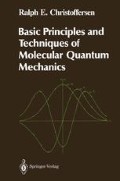Abstract
Having seen that it was necessary to construct a new theory to describe the behavior of sub-microscopic particles, it should not be surprising that mathematical techniques were introduced concurrently to aid in the development of the new theory.
Access this chapter
Tax calculation will be finalised at checkout
Purchases are for personal use only
Preview
Unable to display preview. Download preview PDF.
References
See, for example, Paul R. Halmos, Finite-Dimensional Vector Spaces, Van Nostrand, New York, 1958, pp. 3–4.
See, for example, Advanced Calculus, by A. E. Taylor, Ginn and Co., NY, 1955, Chapter 16.
G. F. Roach, Green’s Functions, van Nostrand Reinhold, New York, 1970.
For a good discussion of the different convergence criteria, see F. W. Byron and R. W. Fuller, Mathematics of Classical and Quantum Physics, Vol. I, Addison-Wesley Publishers, Reading, MA, 1969.
A more general mathematical treatment of this problem shows that both 3C and F belong to an abstract Hilbert space. This shows their basic similarity since both the functions and sequences belong to the same abstract space. For a detailed discussion of this point, see W. Schmeidler, Linear Operators in Hilbert Space,Academic Press, New York, 1965.
For more details, the reader is referred to treatises such as R. Courant and D. Hilbert, Methods of Mathematical Physics, Vol. I, Interscience Publishers, New York, 1953, pp. 69–81.
For additional discussion see, for example, W. Kaplan, Advanced Calculus, Addison-Wesley, Cambridge, MA, 1952, p. 434.
Tables of Integral Transforms Vols. I-II, edited by A. Erdelyi, McGraw-Hill Book Co., New York, 1954.
This “function” was introduced by P. A. M. Dirac, Quantum Mechanics,Oxford University Press, 1958, pp. 58–62.
E. Meibacher, Quantum Mechanics, 2nd ed., Wiley, New York, 1970, pp. 82–85.
Proper proofs of these properties can be given using Distribution Theory (cf. A. Messiah, Quantum Mechanics, Vol. 1, North-Holland Publishing Co., Amsterdam, 1965, Appendix A). The “proofs” given here are strictly formal proofs.
For additional discussion, see G. Arfken, Mathematical Methods for Physicists, Academic Press, New York, 1968, Sect. 17. 6.
More general mappings of the form a: V→V’ are discussed in most advanced books in linear algebra, see, e.g., K. Hoffman and R. Kunze, Linear Algebra, Prentice-Hall, Englewood Cliffs, NJ, 1961.
See, for example, J. Indritz, Methods in Analysis, Macmillan, New York, 1963, p. 22.
For a development of the properties and uses of these operators, see, for example, P. O. Löwdin, Phys. Rev., 97, 1509 (1955)
P. O. Löwdin, Rev. Mod. Phys., 34, 520 (1962)
P. O. Löwdin, J. Math Phys., 3, 969 (1962).
J. V. Neumann, Mathematical Foundations of Quantum Mechanics, Princeton University Press, Princeton, 1955.
P. O. Löwdin, Rev. Modern Phys., 34, 520 (1962).
Author information
Authors and Affiliations
Rights and permissions
Copyright information
© 1989 Springer-Verlag New York Inc.
About this chapter
Cite this chapter
Christoffersen, R.E. (1989). Vector Spaces and Linear Transformations. In: Basic Principles and Techniques of Molecular Quantum Mechanics. Springer Advanced Texts in Chemistry. Springer, New York, NY. https://doi.org/10.1007/978-1-4684-6360-6_2
Download citation
DOI: https://doi.org/10.1007/978-1-4684-6360-6_2
Publisher Name: Springer, New York, NY
Print ISBN: 978-1-4684-6362-0
Online ISBN: 978-1-4684-6360-6
eBook Packages: Springer Book Archive

